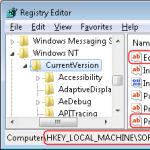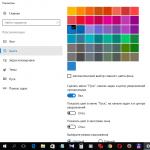When Windows is installed on your computer, it can be installed as a 32-bit version or a 64-bit version of the OS. For most people, whether the operating system is 32-bit or 64-bit does not matter. However, it is important to know whether you are running a 64-bit or 32-bit version of Windows when performing certain tasks on your computer. You should know how to determine the bit depth of Windows 7.
For example, if you are installing new hardware or updating existing hardware drivers, then you must clearly know which version of Windows you are using so that you can download the appropriate and correct drivers for your newly installed hardware. In this article I will try to show how you can determine how to determine the bit depth of Windows 7 or 32 bit or 64 bit version.
In order for you to easily determine the bit depth of Windows 7, Windows Vista or Windows XP, you need to follow a few simple steps. And so let's get started.
Step 1. Click on the button Start, in the menu that opens, right-click on Computer (My Computer), and then Properties.
If you have a My Computer shortcut on your desktop, then you can right-click on it and select the item in the context menu Properties

A window with system settings will open. In this window you will see various information about your computer and Windows.
The item highlighted in red from the system information provided is the bit depth, or in other words, bit depth, and will contain information regarding whether you are using a 32-bit or 64-bit version of Windows. In order to determine the bit depth in Windows XP, you can see the information only if Windows XP is 64-bit, otherwise you will not see the system bit depth, this means that the operating system is 32-bit.

Good afternoon, dear readers, today we will look at what the bit depth of the operating system is and how to find it out. In order to find out the bitness of the Windows operating system, there are several ways, which we will consider below; there is also a video for people who do not like to read.
What is windows bit depth?
Bit capacity refers to the ability to simultaneously process a certain number of bits by the system. There are two types: 32 bits (usually designated x86) and 64 bits.
Their main differences are
- Different levels of maximum supported RAM
- Various commands to the processor
The first way to determine the Windows bit depth
This is to use the System Properties snap-in, you can view it by right-clicking on the My Computer icon and selecting Properties or pressing the Win+Pause Break key combination.

How to determine bit depth in Windows 10
The second way to determine the Windows bit depth
The next way that will help us find out the system type is to open Start and enter system information

How to determine bit depth
or on the right select the floating menu Settings (relevant for versions 8.1) and select system information
You can also enter msinfo32 at startup, it’s essentially the same thing, but in system language.

As a result, a window will open. In it we see very detailed information about everything that is on your computer. We will also be interested in the Type field; in my example, in this field, I have an x64-based computer.

In Windows 10, you can click Start > Settings. There you select System (Display, notifications, applications)

Go to the About the system item, and you see the same field System type 64-bit system, x64 processor.

and of course, no one canceled the search in the system, click the magnifying glass icon in Windows 10 and enter Information in the field that opens, this will be enough for the search to find the required equipment.

Windows bit depth through the registry
Well, for the best part, how to determine the Windows bit version through the registry, press WIN+R and enter regedit. We get to the registry editor and follow the path
HKEY_LOCAL_MACHINE\SOFTWARE\Microsoft\Windows NT\CurrentVersion
Also in the 32-bit version there is no section HKLM\Software\Wow6432Node

Again, there are a large number of utilities and programs that allow you to determine the bit depth of Windows 10, examples include
- CCleaner
- Aida64
- CPU-z

How to change windows bit depth
If you ask yourself how to change the bit depth of Windows, then the answer is no other than reinstalling the system. Save all your data, take bootable media, be it a disk or a flash drive, format the old hard drive and perform a clean installation of the new edition; there are no other methods.
Bottom line
Of course, there are many ways to view the same thing, but I am sure that the average user will stop at the first one, where he needs to look at the properties of the system, the rest require too many body movements, I told you about them for general development, to show that one problem can be solved by several methods . Maybe there are some other ways, I’ll be glad if you write about them in the comments.
If you have asked this question, most likely you want to update the drivers for your video card. You are doing the right thing, because if you download the wrong drivers, the video card will not work at full capacity, or they will not be installed at all. That is why today we will tell you how to find out the bit capacity of the system. Moreover, we will try to sort out all kinds of information that may be required. We haven’t forgotten about the owners of old operating systems a la Windows XP.
Of course, you can run programs or drivers in compatibility mode with a 64-bit system. But, excuse us, these will be some kind of crutches, and not full-fledged working drivers or software.
How to find out the system bit depth on Windows XP
The simplest and most correct option is to look into the system properties window:1. Click on the “My Computer” icon, as expected, RMB. In the drop-down menu that appears, click “Properties”;
2. A window opens where you must go to the “General” tab;
3. If there is no information about the system bit size, then the 32-bit version (x86) is used.

4. Otherwise, if you see another picture and it says, for example, “Professional x64 Edition,” then the system is 64-bit.

Checking system capacity on Windows 7/8/8.1
Here everything is still much simpler, you need:1. Also, right-click on the “Computer” icon and in the context menu that pops up, click on “Properties”;

Strictly speaking, this method is the same for both versions of the operating system, the only difference is in the visual design.
Is it possible to find out the system bit depth in Windows 10?
Of course you can. And you still don’t need to use third-party software. The method is almost the same, but it has its own peculiarity. For example, on most versions of the OS the “Computer” icon is a shortcut, so by right-clicking on it and selecting “Properties” we will get completely different information.
So let's look at our own option. It is simple and versatile. By the way, in the case of Win 7-8 it will also work:
1. Press the Windows + S key combination once. Yes, yes, finally you used the key not during an intense battle in an online shooter. The search bar built into all latest versions of the OS opens;

2. Enter the code word “Computer” into it;

3. Right-click on the first application and click “Properties” in the context menu;
4. After which a window opens, vaguely reminiscent of that in Windows 8.1, where basic information about your computer or laptop is written, including the system’s bit capacity. In this case, this is: 6 GB of RAM, an Intel Core i7 processor and a 64-bit operating system.

Determining the bit depth of the operating system using the AIDA64 program
Why did we choose it? It's simple, with AIDA64 you can get all the necessary information about your computer and even more.1. Open the program from the icon on the desktop - we see the main window;
2. Click on the “Operating System” item;
4. All the necessary information on the OS version and its bit depth becomes available; in the screenshot we have highlighted the line we need with the cursor.
That's all. You are awesome!
Hello everyone, dear friends and readers of my blog. Today I will talk about the bit capacity of systems and processors. About how to find out the bit capacity of the system, what to do if you want to switch from one to another, etc. If there are any misunderstandings, write in the comments, we’ll discuss everything.
I’ll say right away that it’s not particularly rational to describe information about processors and operating systems in this article. The fact is that ordinary users who want to buy a computer or build one themselves should only worry about a couple of things. The basics so to speak. And everything can be described in a nutshell, but I rolled out a whole article. This is where irrationality manifests itself. Although initially I wrote it in a strict direction, but then I began to move towards processors. In general, it turned out to be two in one. The capacity of processors and operating systems is closely related to each other. That's why I rolled it out. But there are also advantages. Most people will understand what's what. About 90 percent. The rest lets go in the comments.
What it is? Give me a definition!
Bit depth is the amount of processed information (bits) performed by a computer processor in one clock cycle. Bit depth or bit depth is nothing more than a way of processing information.
Processors are divided by bit capacity and are currently divided into two categories. The first category is 32-bit (x86) processors, and the second category is 64-bit. I don't know why 32-bit processors are called x84. If you know, please write in the comments.
Of course, there are 16-bit processors, but these are obvious exhibits in museums, the last century. DOS family systems ran on a 16-bit processor. And the amount of supported RAM was less than 1 megabyte! To be more precise, it seems to be 640 kilobytes. Then came 32-bit and relatively recently 64-bit.
By the way, yes, for those who don’t know: bits, bytes, kilobytes, megabytes are all units of information. There are 8 bits in one byte, 1024 bytes in a kilobyte, 1024 kilobytes in a megabyte, etc. The logic is clear.
To make it clearer regarding the definition, I decided to give an example: there is a truck with bricks and a route. The bricks are the beats, the route is the beat. All cars have a certain carrying capacity - bit capacity (the number of information processed). Do you understand what I'm getting at? A route is a step along which a truck with bricks (bits) travels. A one-way trip determines the capacity. Something like this.
Why do you need a 64-bit processor? History in a nutshell
The answer is simple, use it! It all depends on your needs and requirements from the computer. The fact is that at the beginning of 2000 the question of productivity arose. When running programs that consume more RAM, their use on 32-bit systems has become less productive. In general, AMD released a 64-bit processor architecture, which gave a new round to the development of technology. Sixty-four-bit systems, unlike thirty-two-bit systems, are capable of working with large amounts of RAM.
By the way, the first windows operating system that learned to work on a 64-bit processor was and remains windows xp. But again, few people used this particular version, since it was the rising dawn of 64-bit processors.
In general, in fact, the 64-bit processor was invented back in the 90s and was not cheap. Not many could afford such luxury. I don’t know who developed it, but I know that AMD made money, so to speak, by releasing a 64-bit processor to the masses before Intel. That is, she did it first.
What are the differences between 32bit and 64bit windows?
Like processors, Windows operating systems and others are also divided into 32bit and 64bit. When purchasing a disk with an operating system, this must be included on the packaging. Moreover, on a computer with a 32-bit processor, you can install only a 32-bit Windows system, and indeed any 32-bit operating system, respectively. And on a computer with a 64-bit processor, you can install both a 32-bit system and a 64-bit one. Well, in general, any 64-bit systems in principle. It’s just that many people have Windows, which is why I use it in the article.
Only 32-bit systems, so to speak, “see” only 4 gigabytes of RAM, even less - 3.5 gigabytes. 64-bit systems see much more up to 192 gigabytes. It all depends on the hardware capabilities of Windows itself. If someone thinks, what is this even? You don't have to think about it. An easier option is to go and look at the minimum system requirements for hardware that the system distribution requires.
How do you understand difference between 32-bit and 64-bit systems is that the second handles more RAM. You won’t find any visual differences in the official builds.
There is another difference, which is program support. Nowadays you can find programs on the Internet that are written only for a 64-bit system. So here are 64-bit programs won't work on 32-bit windows. But if the system is 64-bit, then on it they will work both 64 and 32-bit programs. In a 64-bit system, there is a subsystem, and when 32-bit programs are launched, they are launched in emulation mode.
Here's an example of the Adobe Premiere program. Designed for video processing, and to work with video, as we know, more random access memory (RAM) is needed. Therefore, the program is released only for 64-bit systems! It makes no sense to release it for 32-bit systems from Adobe. Yes, the program would work, but due to the lack of RAM during actual work it would slow down like a child. In general, Adobe considered the use of this program on 32-bit systems not rational. Now let's move on to determining the bit capacity of systems.
Bit depth in windows vista, 7, 8, 10
First way: In order to determine the bit depth of the Windows system, right-click on the “My Computer” shortcut, which is located on the desktop. Next, click on “Properties” and look at the bit capacity of your Windows.

Second way: is to enter the command into the command line msinfo32. A system program window will open that displays information about the computer. Screenshot below.

This command will probably work on Windows xp. At least that’s what was written on the Microsoft website, but I also checked using zeros.
Bit depth in windows xp
In Windows XP you can find out the bit depth using the same principle, although there are differences, but not big ones. Right click on "My computer", press "Properties". A window will open. Go to the tab "General", you will find information there. You can also log in via "Control Panel", Do not forget.
If nothing is written, namely 86 or 32, then the bit depth is 32-bit. If the system is 64-bit, then you will definitely see this. It will be written.
A universal way to find out the bit depth
What is universal is good. Actually, there’s not much to tell here, a couple of clicks and that’s it.
First way: You can use the Microsoft website, which will actually show us the bit depth by analyzing the computer. Come here. And look here:
And we understand that we are using a 32-bit system.
Second way: enter command systeminfo to the command line.

Third way: download individual programs. Here are the most famous: cpu-z, aida64, speccy.
Determining bit depth in ubuntu
To determine the system capacity, you need to go to "System Information".


You can also use the commands: lscpu.

Or cat /proc/cpuinfo.

It is worth considering that the commands display the bit capacity of the processor, not the operating system itself. But in most cases, the bit depths are the same for both the operating system and the processor itself. As far as I know, the commands work on all versions of Linux.
32 or 64? Which processor is better?

As mentioned, it all depends on your computer requirements. What do you want from him? If you read the article, the answer should present itself. You already understand that a 64-bit processor is powerful. I completely agree with you, but only if it is used in conjunction with RAM, the volume of which is at least 4 gigabytes. If you use less than 4 gigabytes, then do not expect any performance gain. Rather, your operating system will “eat up all” the RAM, leaving you with crumbs left to use.
Nowadays, most processors on the shelves are 64-bit, and there are almost no 32-bit ones left. But this is in my opinion. Unless in some laptops or office computers. A 64-bit processor is reasonable to use for a gaming computer or a computer for video editing. I think the conclusion is clear to you.
That's all. Subscribe to my blog, keep up with the news, of which there are not many. I think I’ll soon start working on the blog and interesting articles will be published more often, but for now I’m completely busy with my studies. Write in the comments if something is unclear, there will be time for an answer. Bye everyone.
When installing any drivers, as well as many programs, you need to know the bitness of your operating system. This is necessary in order to install the optimal software version for your Windows 7/8/10. As a rule, if there are different versions of a program or driver, then before downloading them you are asked to choose: a 32-bit or a 64-bit version. If you don’t need to select anything, then this means it’s a 32-bit program and it will work on any system.
32-bit Windows contain the mark x86 or x32 in the name, and 64-bit Windows - x64. The x86 code has nothing to do with 86 bits, it’s just been the case since the first versions of Windows that worked on computers with an x86-compatible platform (386, 486, 586, who remembers :))
In any version of Windows, the bit depth can be viewed in the system properties window. I'll show you the best way to get there.
Windows 7, Computer -> Properties
Right-click on the “Computer” icon on the desktop and select “Properties”
A system properties window will open in front of you, where you need to find an entry about the type of your Windows

As you can see from the picture, I have a 64-bit system. It's so simple.
Windows 8, Start menu
You can also right-click on the “Computer” icon on the desktop. Or go to the tiled “Start” menu of the eight, find the “Computer” button there, right-click and select “Properties”

In the system properties window, look at the bit depth of your Windows 8

Windows 10 bit depth
Everything is the same, but to open the “System” window, just right-click on “Start” and select “System”

Windows XP
A few words about Windows XP. Since this OS was used mainly on old computers, the x64 version was almost not in demand. Therefore, the system properties window does not even indicate that the x86 version is installed, i.e. this is the default. But if it is x64, then this will be indicated.
Other ways if it doesn't work
If for some reason the above methods do not work, then we will act differently. If there is no “Computer” icon on the desktop, then go to the “Start” menu and write “system” in the search bar

In the search results, select “System” and look.
Second way: go to “Start -> Control Panel -> System”

These two options are suitable for all operating systems: Windows 7 and Windows 8/10. They allow you to show the same system properties window.
The next method is also universal, but it opens another window. So, in the search bar of the Start menu, write “information” and open the link “System Information”

In the main window of the program, look for the line “Type”

For 64-bit OS it will be written “x64-based PC”, and for 32-bit OS “x86-based PC”.
Which system is better: 32 or 64 bit?
Many people ask this question, and for good reason, because a lot depends on it. In general, the bit capacity of the system determines the way the OS interacts with the processor and RAM of a computer or laptop. A thirty-two-bit system can process 32 bits (4 bytes) of information in one processor cycle, and a sixty-four-bit system can process twice as much.
Now, firstly, the ability to run the x64 version on a specific computer directly depends on the bit depth. Fortunately, all modern processors support 64-bit instructions.
If you install a x64 application on x64 Windows, it will work faster than when using 32-bit versions!
Secondly, x86 systems only support 3.25-3.75 GB of RAM (depending on the hardware configuration). Therefore, if you have 4 or more gigabytes of RAM installed, then choose a 64-bit operating system.
But if x64 OS is installed on a computer with 2-3 GB of memory, then it will work, but due to the greater gluttony of this same RAM than x32, the performance will be worse, even despite the faster operation of the processor in such an OS.
If you have x64 Windows, then when downloading programs and drivers, always select their 64-bit version. For drivers, this rule is mandatory. The programs will work in both versions. For 32 programs there is a separate folder on the disk “Program Files (x86)” and they are launched in x86 operating system emulation mode. But you won’t be able to run a 64x program on a 32x system.



